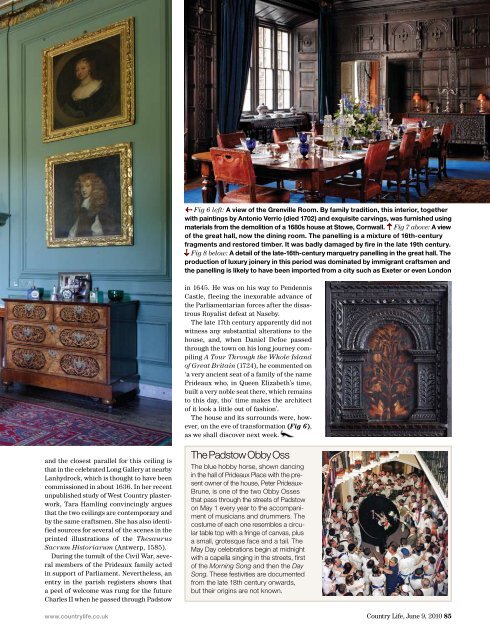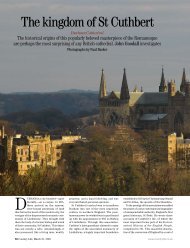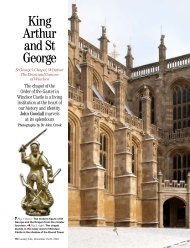Family fortunes - The English Castle
Family fortunes - The English Castle
Family fortunes - The English Castle
You also want an ePaper? Increase the reach of your titles
YUMPU automatically turns print PDFs into web optimized ePapers that Google loves.
and the closest parallel for this ceiling is<br />
that in the celebrated Long Gallery at nearby<br />
Lanhydrock, which is thought to have been<br />
commissioned in about 1636. in her recent<br />
unpublished study of West Country plasterwork,<br />
Tara Hamling convincingly argues<br />
that the two ceilings are contemporary and<br />
by the same craftsmen. She has also identified<br />
sources for several of the scenes in the<br />
printed illustrations of the <strong>The</strong>saurus<br />
Sacrum Historiarum (antwerp, 1585).<br />
during the tumult of the Civil War, several<br />
members of the Prideaux family acted<br />
in support of Parliament. Nevertheless, an<br />
entry in the parish registers shows that<br />
a peel of welcome was rung for the future<br />
Charles ii when he passed through Padstow<br />
Fig 6 left: A view of the Grenville Room. By family tradition, this interior, together<br />
with paintings by Antonio Verrio (died 1702) and exquisite carvings, was furnished using<br />
materials from the demolition of a 1680s house at Stowe, Cornwall. Fig 7 above: A view<br />
of the great hall, now the dining room. <strong>The</strong> panelling is a mixture of 16th-century<br />
fragments and restored timber. It was badly damaged by fire in the late 19th century.<br />
Fig 8 below: A detail of the late-16th-century marquetry panelling in the great hall. <strong>The</strong><br />
production of luxury joinery in this period was dominated by immigrant craftsmen and<br />
the panelling is likely to have been imported from a city such as Exeter or even London<br />
in 1645. He was on his way to Pendennis<br />
<strong>Castle</strong>, fleeing the inexorable advance of<br />
the Parliamentarian forces after the disastrous<br />
royalist defeat at Naseby.<br />
<strong>The</strong> late 17th century apparently did not<br />
witness any substantial alterations to the<br />
house, and, when daniel defoe passed<br />
through the town on his long journey compiling<br />
A Tour Through the Whole Island<br />
of Great Britain (1724), he commented on<br />
‘a very ancient seat of a family of the name<br />
Prideaux who, in Queen elizabeth’s time,<br />
built a very noble seat there, which remains<br />
to this day, tho’ time makes the architect<br />
of it look a little out of fashion’.<br />
<strong>The</strong> house and its surrounds were, however,<br />
on the eve of transformation (Fig 6),<br />
as we shall discover next week.<br />
<strong>The</strong> Padstow Obby Oss<br />
<strong>The</strong> blue hobby horse, shown dancing<br />
in the hall of Prideaux Place with the pre-<br />
sent owner of the house, Peter Prideaux-<br />
Brune, is one of the two Obby Osses<br />
that pass through the streets of Padstow<br />
on May 1 every year to the accompani-<br />
ment of musicians and drummers. <strong>The</strong><br />
costume of each one resembles a circular<br />
table top with a fringe of canvas, plus<br />
a small, grotesque face and a tail. <strong>The</strong><br />
May Day celebrations begin at midnight<br />
with a capella singing in the streets, first<br />
of the Morning Song and then the Day<br />
Song. <strong>The</strong>se festivities are documented<br />
from the late 18th century onwards,<br />
but their origins are not known.<br />
www.countrylife.co.uk Country Life, June 9, 2010 85




